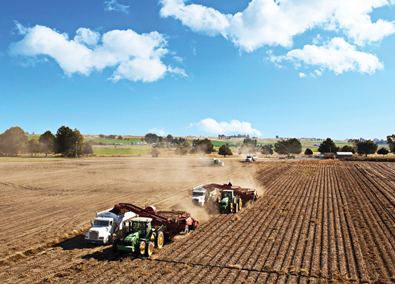Last winter’s heavy snowfall and a wet 2017 spring put Washington potato growers in the fields later than the 2016 season, but reports from the Washington State Potato Commission (WSPC) indicate a good crop is coming in.
Chris Voigt, executive director of the Moses Lake, Wash.-headquartered organization, says all signs are positive.
 “We planted later than the past couple of years due to a wetter spring, but most folks are saying that the last two years were exceptions and this year was a shift back to normal,” Voigt says. “The growing season has been good. It got off to a slow start due to the cooler soil temperatures but is really looking good. Once the soils warmed up, the crop took off, and it’s been great conditions since. There have been a few hot days but not enough to cause any quality concerns.”
“We planted later than the past couple of years due to a wetter spring, but most folks are saying that the last two years were exceptions and this year was a shift back to normal,” Voigt says. “The growing season has been good. It got off to a slow start due to the cooler soil temperatures but is really looking good. Once the soils warmed up, the crop took off, and it’s been great conditions since. There have been a few hot days but not enough to cause any quality concerns.”
All in all, Voigt says, “It’s shaping up to be a really good year.”
Harvest is under way now, he says. “We started digging some early spuds a few weeks ago. Typically we’ll start with some early chipping varieties, followed by some colored varieties out of the Yakima Valley, then some early processing potatoes, then our Norkotahs for the fresh russet market.”
It is estimated Washington has “roughly 25,000 acres planted for the fresh market,” says Voigt, “The amount of fresh acres has been generally flat for the past five years, but as the growth in exports of processed potatoes continues to rise, we are seeing pressure put on our industry to reduce our fresh acres and shift toward more processing.
“About 70 percent of what we grow ends up in export markets, but mostly as processed products,” Voigt continues. “Our primary markets for table-stock potatoes are Canada, Mexico and Taiwan. And we are seeing good growth in fresh chip stock potatoes going overseas, too; Japan and South Korea have been good markets for fresh chip stock.”
The most widely grown potato varieties in Washington are Russet Burbank, Ranger Russet, Umatilla Russet, Russet Norkotah, Chieftain and Shepody, with several other varieties grown in smaller quantities. Voigt says Russet Burbank is the predominant variety, “almost all exclusively for processing.”
“The fresh variety most desired by our customers is the Russet Norkotah, which has a beautiful shape and tastes great,” he adds.
Chieftain is the most popular red variety and is mostly grown in the Skagit Valley or northwestern Washington.
“Our Skagit Valley reds are sought out by buyers who want a cut above the rest in quality and taste,” Voigt says.
Washington sheds ship year-round. “You can get a great Washington russet pretty much any time of the year,” says Voigt. “Our sheds that pack our red, yellow and white potatoes generally finish up in March and April, although one or two may go a little longer depending on the year.”
Like other potato-producing states, Washington has seen consolidation in the industry over the past several years. “Many of Washington’s shippers were some of the first to join into partnerships or marketing agreements,” says Voigt. “Customers want you to be a year supplier and have access to every potato product grown under the sun, and it’s hard for any one single entity to provide that. So we saw various consolidations, marketing agreements and partnerships to meet our customers’ needs.”
As te customers’ needs evolve, so does technology in the fields and sheds.
“Virtually every tractor is auto-steer, and most growers now control their irrigation systems with their phones,” says Voigt. “Growers used to spend their whole day driving around to make sure their irrigation systems were running properly, and now they can do it in mere minutes via their phone or computer … We are all anxiously awaiting when we’ll have self-driving trucks for harvest. Finding enough truck drivers during the harvest season is the biggest complaint I hear.”
Promotion efforts this year by the commission include a refreshed logo that is free for shippers to use in their individual POS materials and bins.
“It works perfectly for customers who want to showcase the locally grown produce of Washington State,” says Voigt.
The WSPC is also continuing its production the Washington Grown television program “as a way of educating the public about the great produce grown in the state and what it took to grow it and get it to their plate,” Voigt says. The commission will be part of the Produce Marketing Association exhibition this year as well.
Source: The Produce News